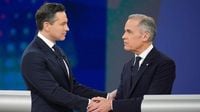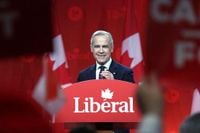As Canadians prepare to head to the polls on April 28, 2025, the political landscape has shifted dramatically, with Prime Minister Mark Carney's Liberal Party currently leading the Conservative Party by a narrow margin. This election, marked by the backdrop of U.S. President Donald Trump's aggressive trade policies and threats of annexation, has seen Carney emerge as a pivotal figure in attracting voter support.
The latest survey from the Angus Reid Institute (ARI), published just days before the election, shows the Liberals holding 44% support compared to 40% for the Conservatives. However, a deeper dive into the data reveals that leadership, rather than party affiliation, has become the key driver of voter sentiment. If voters were to decide based solely on party lines, the Conservatives would maintain their 40% support, while the Liberals would drop to a mere 28%. This indicates that Carney is significantly outpolling his party, leading by 16 percentage points.
Mark Carney, who took over the Liberal leadership in January 2025 after the resignation of long-time Prime Minister Justin Trudeau, has been viewed as a stabilizing force amid the tumultuous political climate. Trudeau's departure came after a decade marked by growing party infighting and declining popularity, exacerbated by economic challenges and rising costs of living.
Carney, a former governor of both the Bank of Canada and the Bank of England, has positioned himself as the candidate capable of addressing Canada's pressing economic issues, including the housing crisis. He has not only refrained from making major blunders during the campaign but has also actively engaged voters with a message of stability and competence.
Political analysts suggest that Carney's ascent is closely tied to the threats posed by the Trump administration. Since Trump imposed a 25% tariff on Canadian imports and hinted at making Canada the 51st state, many Canadians have rallied around the idea of national sovereignty. Political scientist Andrew McDougall noted, "Mark Carney seems to be sort of the man of the hour. He’s definitely got a resume that Canadians seem to have responded to." His experience has resonated with voters who are concerned about the implications of U.S. policies on their economy and independence.
In contrast, Pierre Poilievre, leader of the Conservative Party, has focused on a populist message, advocating for deregulation and a market-driven approach to economic recovery. His campaign has emphasized a tough stance on crime, appealing to voters' concerns about public safety. However, Poilievre's support remains concentrated in Western provinces like Saskatchewan and Alberta, which may not translate into enough seats due to the distribution of votes across Canada.
As the election approaches, early voting statistics indicate a strong preference for the Liberals among those who have already cast their ballots. According to ARI data, 46% of early voters support the ruling party, giving them a 12-point advantage over the Conservatives. This trend suggests that Carney's leadership is resonating with voters looking for a steady hand in uncertain times.
The political dynamics have shifted significantly since December 2024, when the Liberals trailed the Conservatives by over 20 points. The dramatic turnaround is attributed to Carney's leadership style and the increasing focus on U.S.-Canada relations, which have dominated the campaign narrative. As the election nears, many Canadians are prioritizing their choice based on which leader they believe can best navigate the complexities of international relations and domestic economic challenges.
On the ground, the atmosphere is charged with anticipation. Voters are not only concerned about the immediate economic implications of the election but also about the long-term direction of the country. The number of registered voters has increased to 28 million, with the election being managed by Elections Canada, an independent body responsible for overseeing the voting process. The stakes are high, as the party that wins the most seats in the House of Commons will form the government, with 172 seats needed for a majority.
In the past, the Conservative Party has won the popular vote in previous elections but failed to secure a majority due to the distribution of their support. This election could follow a similar pattern, with the Liberals potentially gaining more seats despite a tighter national vote. The first-past-the-post electoral system in Canada often favors parties with broader, more evenly distributed support, which has historically benefited the Liberals.
As the final hours before the election tick down, both parties are making their final appeals to voters. Carney's campaign has leveraged the fear of Trump's policies to galvanize support, while Poilievre has sought to present himself as a viable alternative, promising to address the cost of living crisis and housing affordability. The election is seen as a pivotal moment for Canada, with implications that extend far beyond its borders.
In the lead-up to the election, Carney has been vocal about the need for strong leadership in the face of external threats. He has framed the election as a choice between stability and uncertainty, urging Canadians to consider the long-term consequences of their votes. The stark contrast between the two candidates' approaches to governance and economic management has set the stage for what could be one of the most consequential elections in Canadian history.
Ultimately, Canadians will head to the polls tomorrow, faced with a choice that will shape the future of their nation. With the election just around the corner, the question remains: will voters prioritize Carney's experience and stability or Poilievre's vision for change?





